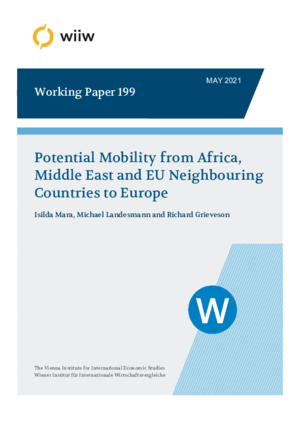Potential Mobility from Africa, Middle East and EU Neighbouring Countries to Europe
Richard Grieveson, Michael Landesmann and Isilda Mara
wiiw Working Paper No. 199, May 2021
35 pages including 2 Tables and 14 Figures
Migration from Africa and the Middle East to the EU has intensified over the last two decades. Relative differences between developed EU and less developed African and Middle East countries have not declined that much and continue to drive mobility. Also, demographic trends show a strong contrast between the population of the EU (ageing and shrinking rapidly) and that of Africa and the Middle East (young and continuously increasing). Apart from demographic pressures and development gaps, other forces related to conflicts and wars, as well as climate risks, have become important drivers of mobility and are not expected to fade away soon. Anticipating migration flows in order to ensure better management and regulated mobility has become essential, although this is an exercise subject to high uncertainty. With these caveats in mind, this study seeks to calculate long-term potential mobility from Africa, the Middle East and Eastern EU neighbouring countries to EU28 and EFTA by applying a migration gravity model following a scenario-based approach. Projections for 2020-2029 suggest that migration flows to the EU from Africa, in particular, will dominate the South-North mobility corridor. Migration policies will also play a role in shaping future migration trends, as migration flows are subject to EU destination countries’ applying restrictive migration policies.
Keywords: International Migration, forecasting, scenario, gravity model, EU, Africa
JEL classification: F22, J11, J61, O15
Countries covered: Africa, CEE, EU neighbouring countries, European Union, Middle East, New EU Member States, Wider Europe
Research Areas: Labour, Migration and Income Distribution
